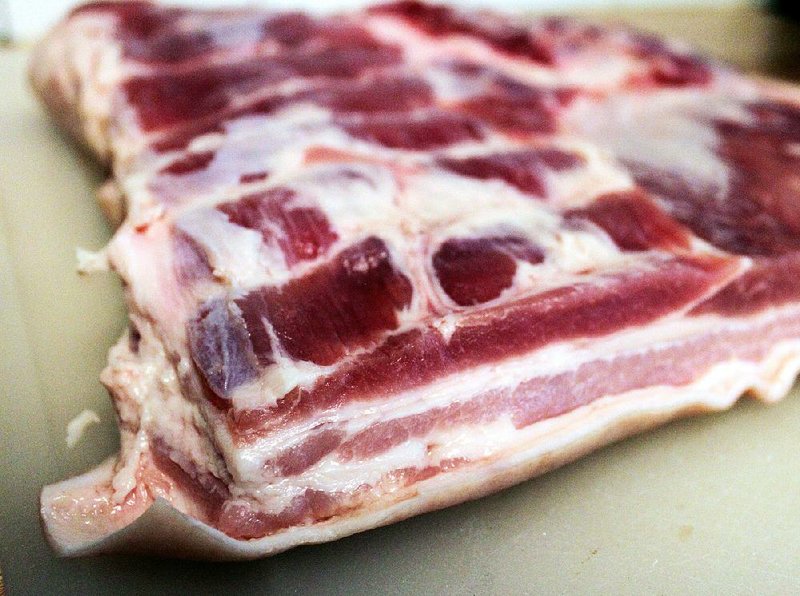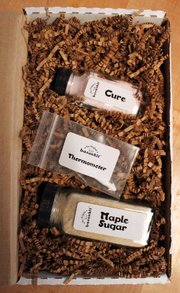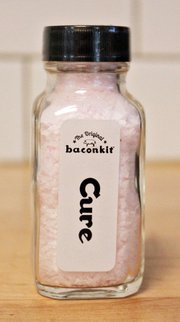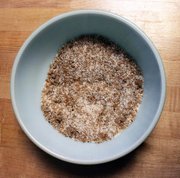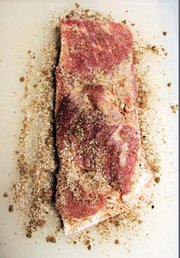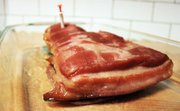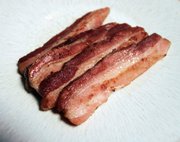After days of anticipation, the moment arrived: The do-it-yourself bacon brining in the refrigerator for a week had been cured and was ready to slice, fry, eat.


My mouth watered with expectation.
I cut huge, thick -- really thick, the way I like bacon -- slices of pork and settled them in the hot skillet. The homemade bacon, which a week earlier had been pork belly, popped and sizzled. The aroma of pork on hot metal filled the kitchen. This was a fine start.
And to think, this bacon started as nothing more than 6 pounds of raw pork belly (or fresh side meat), bought from Hogg's Meat Market in North Little Rock.
Now, I was readying to dine like a bacon god.
My charge for this story had been simple: Buy some pork belly and make bacon at home using two methods. The first technique was following a recipe for Classic Cured Bacon by Australian-born/New York state-based chef Christopher Rendell from the I Love Bacon! cookbook by Jayne Rockmill.
The second system was using The Original Baconkit, a do-it-yourself kit developed by 7th West Charcuterie in Seattle and bought online ($19.99, baconkit.com).
The meat had been easy to find, and after a Saturday morning visit to Hogg's I was the proud owner of pork belly ($4.49 a pound). But finding the curing salt the cookbook's recipe called for was an obstacle.
Turns out, curing salt is not one of those things that the neighborhood grocery store carries. Or most any store. One butcher shop in town said they'd sell me a pound of it, but all that was needed was 1/4 cup for the I Love Bacon! recipe. (The Baconkit comes with its own curing salt.)
What to do? Adapt, overcome, improvise. I'd split the curing salt in the Baconkit between the recipes. The kit contains enough curing salt for 5 pounds and after cutting away some excess fat from the pork belly I was left with roughly 5 pounds to divide between the two recipes.
Genius.
Two pounds of the pork belly were prepared via the cookbook method (recipe with this story); 3 pounds were assembled per the kit (which contains a curing bag, curing salt, maple sugar, thermometer and instructions).
Pork belly brining, it was placed in the refrigerator, where all I did was flip it once a day.
Seven days later, the pork belly -- after a bake in the oven for curing -- was transformed into bacon.
After removing the skin from each slab, I sliced off several strips of bacon, only cutting my left index finger once, which I considered a triumph.
Now, after a few minutes in the skillet and some turns, the bacon made from I Love Bacon! was ready for eating.
I bit into it.
No. No, no, no.
Bacon is not supposed to be this salty. Not at all.
In a quest to create do-it-yourself bacon, I'd concocted salt-cured ham. Or Spam. Or a pork that early 19th-century whalers would've gladly gnawed on for years while sailing around the world in search of prey.
Certainly this creation wasn't bacon. Undeterred, I popped another piece into my mouth and the salt sponged up all the saliva.
I didn't chew but sucked the salt out of the "bacon." There, at the very end, before the slice of meat lost all its flavor, a hint of bacon taste. It was a clue that this might have been bacon. That's all.
There was a quick recheck of the cookbook's recipe. That 1/2 cup of kosher salt for 2 pounds of pork belly? Way, way too much. This "bacon" would only be useful as a seasoning component.
Fortunately, there was still 3 pounds of bacon prepared via the Baconkit method. Perhaps this 3 pounds would deliver redemption.
Again, chunky slices of bacon were sliced and slid into the skillet. The bacon danced in the hot grease and snapped with the sound of bacon salvation.
I pulled the bacon from the skillet, patted it dry of the grease and ... hesitated. Oh, I was nervous. What if this slab of bacon was likewise too salty or otherwise inedible? What if $27 worth of pork belly had just been wasted? Not to mention a week's worth of suspense?
It was time to end this uncertainty. I bit into the bacon.
It tasted glorious. I danced around the kitchen, beating my chest with one fist and exclaiming, "Aha! Look what I've created. I have made bacon."
To me, it was gobsmackingly perfect: a quarter-inch broad, still juicy (and definitely not burned to a crisp), only slightly salty, a tad sweet and completely, utterly savory.
One slice devoured, I gobbled down three more.
This is what bacon is supposed to taste like, and it was all so simple. I'd only placed 3 pounds of pork belly into a curing bag and added curing salt and maple sugar. A week later, it was ready for a quick bake and then it was tasty, divine bacon.
Simple enough. Or was it?
The Baconkit cost $25.89 (that's with shipping tossed in). The pork belly was $27.52. A week of waiting had passed by. A few hours of labor bookended that seven days when the pork belly was brining, including a lot of sanitizing the kitchen surfaces that had contacted the raw pork.
And about 2 pounds of the bacon based on the cookbook recipe had been rendered uneatable.
No, this making-bacon experiment had been a lot of work.
There are easier, more direct methods for procuring bacon. Four pounds of thick, hickory-smoked bacon from Petit Jean Meats, ordered online, would've set me back $42.99. Wright Brand bacon from a local Kroger or Wal-Mart would've been cheaper and easier.
There might be something to be said for the do-it-yourself ethos. Something, like I made bacon from pork belly. That knowledge was about it, and that's little satisfaction.
Plus, 4 pounds of bacon between the two recipes remained. Sure, it can be stored for weeks in the refrigerator (though the too-salty bacon will be frozen for winter stews and such), but I'm not a bacon fanatic.
How much bacon does a man need? Sure, it's grand, but not for every meal or even every breakfast. Plus, think of the arteries.
But let's don't call this homemade bacon thing a failure. Lessons have been learned. Most importantly? Convenience isn't a terrible concept.
There are some endeavors we don't tackle at home because we're not equipped to perform these complicated tasks. Lasik eye surgery is just one example.
Other undertakings we can do at home, but it's just easier not to. I'm placing making bacon into this category. After all, the modern grocery store -- with its rows and rows of bacon for the choosing -- is a wonderful convenience.
That's where I'll find my bacon next time.
Classic Cured Bacon
1/2 cup dark brown sugar
1/2 cup kosher salt
1/4 cup pink curing salt
3/4 teaspoon coarsely ground black peppercorns
1 (2-pound) pork belly, skin on
Combine the dark brown sugar, kosher salt, pink (or curing) salt and pepper in a medium bowl and mix well.
Rub the mixture into the pork belly until completely coated.
Place pork belly in resealable storage container, seal tightly and place in refrigerator for 1 week.
After 1 week of brining, remove the pork belly from the refrigerator.
The original recipe doesn't call for rinsing the pork belly, but the Baconkit's instructions state the pork belly should be rinsed and patted dry before curing. Other online do-it-yourself bacon recipes referenced also include a step that involves rinsing the brine from the pork belly.
Heat oven to 300 degrees. Place the pork belly on a baking sheet and cover with parchment paper and aluminum foil and bake until the internal temperature reaches 156 degrees, about 1 hour.
Remove from oven and allow to cool in the refrigerator.
Bacon will keep for weeks covered tightly in refrigerator. Slice off pieces as needed.
Makes about 2 pounds.
Recipe adapted from I Love Bacon! by Jayne Rockmill (Andrews McMeel Publishing, 2010)
Food on 06/22/2016
